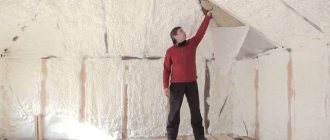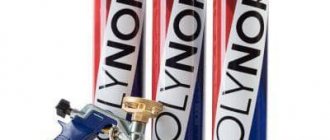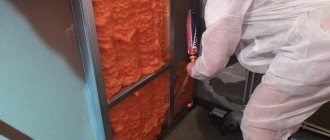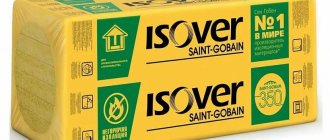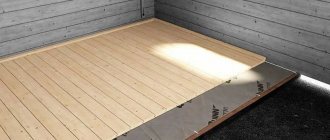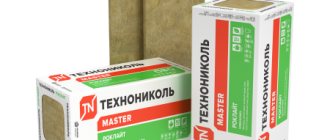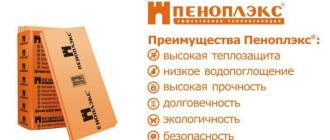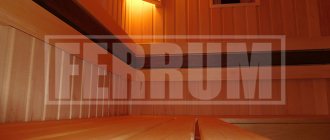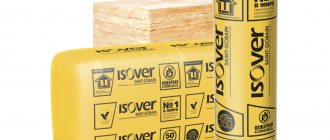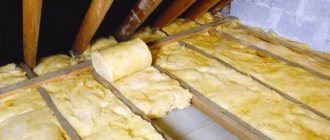The issue of creating effective thermal protection for a home is now more relevant than ever. This is dictated by the rise in prices of energy resources and the desire of developers to equip a comfortable home in which the whole family can spend time comfortably. The choice of insulation is quite large, so that the purchase does not disappoint, it is suggested that you familiarize yourself with the technical characteristics and rules of use of a particular insulator. The article will discuss a new type of heat-protective material - Polinor.
Polinor is a type of insulation that is produced in cylinders. A polyurethane foam product with a one-component composition, when released from a container, forms cells filled with carbon dioxide. The insulator structure is unique and has low thermal conductivity (within 0.028 W/m•K). The product is packaged in small cylinders, which creates certain convenience when performing installation work.
A special feature of Polinor is the absence of analogues. In appearance, the product is similar to polyurethane foam, but the structure of the materials and their properties are different.
Reference! Due to its physical properties and qualities, a 45 mm thick Polinor insulation layer replaces the following popular insulators: PPU polyurethane foam - 60 mm, PPS polystyrene foam - 130 mm, cork - 140 mm, mineral wool 150 mm.
Scope of application
The description of the insulation presents us with a modern, almost universal material, which has a fairly wide application as a finishing and insulating material, in particular:
- for facades for finishing;
- for foundations and attics;
- for balconies;
- for insulation of internal walls of a building, partitions in various buildings;
- to isolate communication systems;
- in vehicles with isothermal functions.
As you can see, the application is wide. And this is understandable, since the heat insulator has good performance properties, fits perfectly on any surface, is very flexible and is not subject to destruction, even if a crack appears on the surface. The material is non-toxic and perfectly absorbs sound and vibration waves.
Surface geometry
A common mistake is when the calculation of the area for a flat plastered wall and for brickwork with jointing or for a profiled metal sheet is carried out in the same way. The actual area of foam spraying on an area of 1 x 1 linear meter will differ from 1 sq.m. Brickwork with deep jointing can have a spray area of 1.05 or even 1.1 sq.m per 1x1 linear meter, and a profiled sheet is even larger - up to 1.8 sq.m. Imagine a crumpled sheet of paper, it is not very long, but once we smooth it out... The same effect is here. The surface needs to be “unfolded” - we take a linear meter and calculate what real area it will give.
I will give some examples of correction factors for a number of surfaces:
- Brickwork with shallow jointing + 2-5% to PU foam consumption
- Brickwork with deep jointing + 5-10% to PU foam consumption
- Profiled sheet with a profile height of 8 mm + 10-15% to PU foam consumption
- Profiled sheet with a profile height of 10 mm + 20-25% to PU foam consumption
- Profiled sheet with a profile height of 18 mm + 40-50% of PPU consumption
- Profiled sheet with a profile height of 44 mm + 50-60% of PPU consumption
And so on for other branched surfaces.
How to choose from all the varieties
The choice of type of insulation depends on the situation, as well as the area of application; let’s consider some common cases in which foam insulation is used:
- You can use polyurethane if you need to repair cracks or eliminate other defects on the walls. Do not expose it to direct sunlight.
- To fill large volumes, use penoizol. In this case, it is necessary to purchase a special high-pressure apparatus, since a regular cylinder will not be enough for this.
- To seal cracks and thermally insulate a small surface area, select mounting samples in cylinders. It does not ignite when interacting with fire, does not support combustion, has an environmental composition and hardness after hardening.
Remember! Polyurethane foam is categorically not suitable for insulating the entire building, since it does not have the appropriate characteristics.
To eliminate defects that have been detected externally, foam, which contains polyurethane, is applied using direct method technology, using a machine or a special cylinder. Errors within the layer that foam insulation creates require a long hose to push the material through. To fill the air gaps inside the insulation, holes are made in the wall.
Release form
Sprayed insulation has been known since 2013. It is a one-component self-expanding mixture with a closed-cell structure.
In construction stores, this thermal insulation is sold in cylinders similar to conventional foam for a gun.
It is applied in the same way as construction foam. According to reviews, one cylinder is enough for a 5-centimeter layer of insulation over an area of one square meter. The manufacturer's instructions state that the service life, in the absence of exposure to negative factors, will be at least 35 years.
Possibility of using foam fillers
Then manufacturers began to produce sprayed insulation in compact-sized cylinders, which led to a reduction in the cost of the method. To spray such a mixture of steel, complex installations and specialists in thermal insulation finishing are not needed, since the material itself is filled into small containers and the possibility of manual spraying is provided. Each cylinder is designed to cover one square meter of base (layer up to 60 mm thick). One person can process up to one hundred square meters per day.
As a result, calculations showed that working with insulation such as Polynor is much more profitable in terms of labor costs, costs for the materials themselves and surface preparation. If a professional team of workers charges up to one and a half thousand rubles for insulating one square of wall, then using Polinor insulation with the same amount of material, you need to spend only about 500 rubles. You can work independently, which eliminates the need to look for experienced workers, reduces finishing time, and saves money.
The choice of thermal insulation of this type remains the only optimal option that is available to people without special training. Foam can be used to create insulation for foundations, basements, walls inside and outside buildings made of brick, stone, concrete, and blocks. This option is also suitable for thermal insulation of non-load-bearing coatings, including floors on joists, as well as pitched roofs and attic floors.
Since Polinor is suitable for application to bases made of almost any material, it can be used as thermal insulation for plumbing fixtures and sewer pipes or fittings. In such cases, foam insulation in cylinders can be used indoors or in open areas. There is only one limitation on the use of balloon thermal insulation, which is that the material cannot be used to foam voids. It can only be applied to a dense base.
https://youtube.com/watch?v=HzNxMCfzjrE
Using the attachment
“Polinor” is a sprayed insulation material that is applied with a special plastic spray nozzle. It is attached to the tip of a regular mounting gun, and to do this you need to remove the nozzle from the sprayer, press it against the tip of the gun, then insert it into the spray nozzle until it clicks. The main thing is not to allow too much stress, as this can lead to cracking of the nozzle body. The nozzle cannot be used to work with regular polyurethane foam.
After the insulation has been applied, you can treat it with water using a regular garden sprayer - this will speed up the polymerization and better foaming of the newly created thermal insulation layer.
Advantages and disadvantages
There are no ideal materials among insulation materials; all have not only advantages, but also disadvantages. Polyurethane foam material has a number of advantages over other heat insulators:
- Low thermal conductivity. Polyurethane foam is a good barrier to heat loss. It is perfect for internal thermal insulation, as it is enough to apply a small layer of foam.
- Waterproofing properties. The composition of the material allows it to be used as waterproofing. It perfectly protects against corrosion.
- No seams. The method of applying insulation (spraying) allows you to obtain a seamless layer. There are no joints formed in the areas where the foam adheres, through which the cold passes.
- High adhesion. The insulation adheres well to any building materials, the surface of which has been previously cleaned of debris, dust and degreased.
- Chemical neutrality. Polyurethane foam does not react chemically with other building materials and installation solutions. The insulation layer is resistant to aggressive chemicals (except petroleum products).
- High strength. After the foam polymerizes, it becomes so strong that it can withstand strong mechanical loads. It can even be used to insulate foundations that are buried in the soil. During operation, polyurethane also shows high strength.
- Fire safety. Due to the fact that the composition includes a fire retardant, this insulation has been awarded a fire safety certificate. The material not only ignites poorly, but also contributes to the self-extinguishing of fire.
- Long service life. Polyurethane does not absorb water, thanks to which it is not destroyed by adverse weather conditions and temperature changes (with the exception of ultraviolet rays). If all conditions were met during installation, it will retain its high technical characteristics for at least 50 years.
- Easy to install. Any craftsman can handle spraying insulation; there is no need to nail down brackets or install sheathing.
Disadvantages of sprayed polyurethane insulation:
- The material is characterized by low ultraviolet resistance. When irradiated, the structure of polyurethane foam disintegrates, so it is always protected from the outside with decorative materials. Cement plaster, panels, and siding are used.
- The work requires the use of special equipment. A compressor is required for spraying, and a construction mixer is required for mixing the components. It is not necessary to buy all this equipment; it can be rented.
- It is necessary to use protective equipment. When spraying polyurethane, a large amount of carbon dioxide is released, which is harmful to humans. Work should be carried out in a respirator and overalls (or other protective clothing).
- High price. Spray insulation is more expensive than other insulation materials - mineral wool or polystyrene foam.
Precautionary measures
Despite the safety of the Polinor composition, it is recommended to observe the following precautions when performing insulation measures.
• When the composition is released from the cylinder, there is an increased concentration of the chemical components of the insulator, which can cause irritation of the mucous membranes of the eyes, respiratory organs, and skin. Therefore, work should be carried out in special clothing, safety glasses, a mask or a respirator.
• Do not spray the contents of the cylinder near an open flame. The presence of gas may cause a fire. It is also prohibited to combine installation with smoking cigarettes.
• In the room where thermal protection is installed, you need to open windows and doors to organize good air ventilation.
In general, working with polyurethane foam insulator Polinor, produced in cylinders, is characterized by simplicity and uncomplicated application techniques, which is confirmed by user reviews.
Receiving PPU
When mixed, polyol and isocyanate produce foam, which increases in volume and then hardens. During the manufacturing process, it is necessary to adhere to a number of requirements: maintain the required temperature and mix all components well, which makes it possible to obtain a polyurethane output that does not have seals and large air cavities.
If you change the production method, you get polyurethane foams that differ in their basic characteristics. Some are better suited for insulating openings for doors and windows, others for brick and panel buildings or pipelines. By changing the proportions of the ingredients, when mixing them, polyurethane foam with different cell sizes is obtained.
The most popular materials in this group are the following:
- Foam rubber. It is widely used in everyday life and is familiar to every person. It is used as an upholstery filler for upholstered furniture and lining material.
- Rigid polyurethane foam is used when performing installation work. It has been noticed that this insulation is negatively affected by acids and solvents.
Apparent density
Beginning polyurethane foam sprayers sometimes make the mistake of mistaking the apparent density of polyurethane foam (this is a scientific term) indicated in the product passport for the actual density obtained in real conditions of a construction site. The fact is that manufacturers determine the density of the supplied foam in “greenhouse” laboratory conditions. Mix on a special high-speed laboratory mixer at room temperature of the environment and components. Of course, there are no such conditions at the site. Therefore, such density cannot be achieved. In practice, even under satisfactory spraying conditions, the density of polyurethane foam is 5-10% higher than the apparent one. And this also requires taking into account when calculating the consumption of raw materials.
Comparisons of POLYNOR with other insulation materials
POLYNOR (polynor) - can be compared with many materials and insulation materials, but we will focus on the most basic ones.
We consider the economics or the true cost of insulation
When choosing any product or building material, the question always arises regarding the price/quality ratio. I would like to do everything efficiently, relatively inexpensively and not return to this issue for a long time. When insulating, it is not enough to choose the insulation you like based only on the cost and its physical and chemical properties, but you also need to understand what additional costs will arise during the work. Let's consider this using the example of traditional insulation materials: polynor, mineral wool, expanded polystyrene and polystyrene foam for an insulation area of 100 m2.
The thermal conductivity coefficient of Polynor thermal insulation is 0.023 W/(m*deg.). This is the minimum indicator among the insulation listed above! The number of closed cells is 70%. Based on this and similar parameters for other insulation materials, the thicknesses required for insulation, all other things being equal, were determined:
Mineral wool -15cm.
Accordingly, the required volume and cost of the material itself (at Leroy Merlin prices as of December 5, 2014):
Polynor - 5m3 (or 100 cylinders) X 325 rub. = 32500 rub.
Mineral wool (Ursa Terra 34PN, 50mm.) - 15m3./70rub. per m2. RUR 21,000. Expanded polystyrene (URSA XPS, 50mm) - 13m3. /224 rub. per m2. 58240 RUB. Polystyrene foam (PSB-S15U, 1x0.6x0.03) - 15 m3/36.3 RUB. per m2. 18150 rub.
Now let's move on to the second part of the question - additional costs for installing thermal insulation, the cost of work and delivery of insulation materials to the construction site.
Transportation. Polynor is produced in cylinders with a capacity of 1 liter, the covered area is 5 cm thick. is 1m2. For 100 m2 you will need 100 cylinders or 9 boxes. Transportation costs are insignificant, unlike other compared insulation materials. Their transportation requires special transport.
Cost of work. Polynor is a high-tech material, there are no requirements for the preparation of the insulated surface, it does not require lathing or vapor barrier, any person without special skills can apply PPU insulation. As a rule, construction company prices for work are 90-100% of the cost of the material itself, but this does not apply to the Polynor brand. You can apply it yourself or negotiate at your own discretion (maximum 30% of the cost of the material).
At Leroy Merlin prices as of 12/05/2014:
Vapor barrier Izospan, roll 70m2-950rub/piece.
Hydro-windproof membrane Izospan AM, roll 35m2-30 RUR/m2.
Mounting adhesive Tytan Prof Classic Fix - 139 RUR/pc.
Cost of thermal insulation materials per 100m2
hydro windproof membrane
The cost of the required materials was calculated based on the amount of materials used:
- Edged board: distance between logs 1 m. Board section: 0.02X0.08m. Cubic capacity: 100X0.02X0.08=0.16m3. Cost: 0.16m3X7000rub.=1120rub. 1a. This section of the board when insulating Polynor is necessary and sufficient to ensure the solidity of the entire insulated structure as a whole, eliminates the temperature gradient, cold bridges and moves the dew point outside the insulated plane.
- Lathing + counter-lattice: Cell format - 0.6X1.2. With this format, the amount of timber per 100m2 is 25 pieces with a length of 10m. Section of timber: 0.05X0.15m. Cubic capacity: 250X0.05X0.15=1.875m3. Cost: 1.875m3X7000rub.=13125rub.
- Vapor barrier: Cost: 100m2-1360rub.
- Hydro-windproof membrane: Cost: 105m2-3150rub.
- Assembly adhesive: 17 pcs x 139 rubles = 2363 rubles.
Mineral wool: 5-7 years (further absorbs moisture and becomes deformed)
Expanded polystyrene: PPS_JSC JV Tigi Knauf _ GOST 15588-70_13 years EPPS_NPP "Expol"_TU 2244-001-17953000-97_34 years EPPS_ZAO "Khimich. Plant"_TU 2244-002-17953000-95_16 years Eps Flomate_ "Dow Chemical"_DIN 4108_37 years Eps Roofmate_ "Dow Chemical"_DIN 4108_40 years Foam plastic: at least 30 years Polynor: 45 years
Thus, to summarize: we see that Polynor is in the middle price segment between mineral wool and expanded polystyrene, but in terms of the totality of all costs for arranging thermal insulation, durability and transportation, it is confidently in the lead.
Absorbent bases
Some building materials have absorption properties in relation to liquid PU foam components that have not yet had time to foam. Thus, these materials absorb part of the raw material, thereby increasing the required number of components to obtain a given thickness of polyurethane foam. This is especially true for such porous materials as foam concrete, aerated concrete, expanded clay concrete, wood and some types of brick. If you are faced with the need to spray polyurethane foam onto these materials, then you need to take into account the possible excess consumption of raw materials. In the case of absorption, the overconsumption directly depends on the thickness of the polyurethane foam layer - the smaller the layer needed, the higher the overconsumption will be relative to the total amount of raw materials. This is due to the fact that only the first layer is absorbed when sprayed.
You can visually assess the absorption capacity of a material in a simple way. To do this, you need to take some water and splash it onto the surface. If the water does not drain, but is completely absorbed, leaving only a dull dark spot, then the absorption capacity is high. If the water is partially absorbed and partially flows down in a stream, then the absorption capacity is average. If water does not change the color of the material, forms drops on the surface and flows down to the floor, then the absorption capacity of the material can be ignored.
Advantages and disadvantages of Polinor
Let's start with the good:
- Simple installation compared to other insulation materials, which does not require the construction of a frame and other materials (isospan film, glue, fasteners, reinforcing mesh, etc.);
- Convenience when working in places with difficult access, complex geometry of the surface to be coated, as well as in limited space;
- The technological process of applying Polinor does not require special equipment or electricity;
- Excellent adhesion to various materials (brick, wood, foam concrete, metal, glass, etc.);
- One of the best (among other traditional insulation) thermal conductivity;
- Coverage speed. To apply a thermal insulation layer of 1 m², 1-2 minutes is enough;
- Low consumption. One 1000 ml bottle is enough to cover 1 m² with a layer thickness of 5 cm, and thanks to the compact packaging you can always buy more without excess;
- Polymerization (hardening) occurs within an hour. After which, Polinor can be coated (paint, plaster, etc.) or other protection;
- Long service life, according to the manufacturer, from 35 to 50 years;
- Environmental Safety. During operation it does not emit harmful substances;
- In addition to thermal insulation, it provides sound insulation and does not condense;
- We do not like rodents, insects, fungal mold and other biological activity.
There are so many useful and convenient things. Now I'll tell you about the disadvantages:
- Low resistance to direct solar radiation, just like polyurethane foam is “afraid” of ultraviolet radiation;
- Fragility with regular contact with water;
- Limited temperature conditions during installation. The temperature of the cylinder at the time of the process should be in the range from + 18° to + 35°C. In this case, application is possible up to t = - 20°C.
- Toxicity at work. Therefore, the use of personal protective equipment: masks, respirators, skin covering is mandatory;
- Difficulty in applying a uniform layer thickness. The result is the risk of obtaining non-uniform thermal conductivity of the treated coating. But with experience, the quality of spray uniformity increases;
- Limitations on layer thickness of 6 cm (this is the manufacturer’s recommendation);
- Polynor is not hygroscopic, therefore it creates a sealing of the surface, which eliminates its “breathing”, and therefore the ability to absorb vapor;
- The insulation is sold in cylinders, for which you need to separately purchase a construction gun with a special nozzle. If the gun or attachment is lost (broken), you will have to buy a new one. Without it, it is impossible to carry out a high-quality process (as the manufacturer claims).
We insulate OSB wall boards.
At the end of this question, it is necessary to mention an important point - the flammability of Polinor. It belongs to the so-called self-extinguishing materials, but this is only in the absence of direct and constant exposure to fire
Its flammability class is G3 (i.e., medium flammable).
Well, one more point stated by the manufacturer: POLYNOR analogues are not produced in the world and in Russia. Whether this is good news or not, depends on how you look at it... But it’s up to you to judge how balanced the pros and cons of the material are.
Where is the material used?
Scope of application
New generation foam insulation is used for external and internal application. Depending on the characteristics of the objects, materials with open and closed cells are used.
Spraying is carried out on the following structures:
- Roofs of residential, commercial, administrative buildings and engineering structures. Since the main heat losses occur through the roof, a layer 10-15 cm thick is applied for high-quality insulation. When working in attic spaces, no additional finishing is required. Sprayed Polynor insulation, once cured, forms a durable outer skin. There are no odors or discharge.
- Technological containers. The use of polyurethane foam in cylinders for insulation of various tanks helps maintain a given temperature in them with minimal energy consumption. Domestic and industrial boilers are filled with polyurethane, foam is applied to the walls of swimming pools, storage facilities and other containers for storing and transporting various liquids that require stable conditions. In addition to tanks, foam is used to insulate pipes connected to them with a diameter of 20 cm or more.
- Walls. For harsh climates, Polynor insulation is an excellent solution to the problem of combating freezing of load-bearing structures. The material is in no way inferior in its characteristics to Penoplex roll insulation, surpassing it in speed of application and durability. The thickness of the layer varies between 5-10 cm depending on the type of structure and climate characteristics. Spraying is carried out inside the lattice frame, which is then covered with decorative cladding.
- Floors. A thick layer of PP is an excellent protection against cold and dampness coming from the ground or unheated basements. The material is applied to a concrete slab or subfloor in a wooden house. The lathing is pre-made, which is the basis for laying the finishing or intermediate coating. Ventilation of rooms is achieved by installing vents. The recommended application layer is 7-10 cm.
- Attics. Insulating these residential buildings with polyurethane foam allows you to create comfortable living conditions at any time of the year. To create a reliable barrier from cold and heat, you should spray at least 15 cm of foam. After this, the internal surfaces of the attic are sheathed with plasterboard, plywood or solid boards.
Depending on the treatment area, industrial equipment or one-time sprayers are selected.
Liquid insulation brand POLYNOR
The use of most heat and sound insulation materials in repair and construction work involves a rather complex installation technology that requires special tools and certain skills. An alternative solution to this issue was the fundamentally new liquid insulation POLYNOR, which stands out from the general background due to its ease of use along with high performance and technical characteristics.
POLINOR insulation has a polyurethane foam base, which is a foamed polymer mass with a percentage of gases to solid particles in a ratio of 90:10. When interacting with air, this substance “swells” and hardens (like polyurethane foam), creating a dense, monolithic fine-mesh coating without the slightest cracks or gaps.
Due to its structure, POLYNOR material easily penetrates into the most inaccessible places and is perfectly fixed on the surface of metal, wood, concrete or brick. The insulation is packaged in aerosol cans with a capacity of 800–1000 mm in the form of a plastic mass of cream or pink color, which can be sprayed using a special mounting gun.
Liquid insulation POLINOR has significant differences from its analogues. First of all, this concerns its structure, namely, the percentage of closed and open cells (pores) in the frozen mass. This value is an important indicator that affects the degree of thermal conductivity, moisture absorption and water permeability of the material. Other spray-on thermal insulation products can provide a coating with 30-40% closed cells, while POLINOR creates more than 70% of these pores.
This material has the lowest thermal conductivity among insulators presented on the Russian market. For example, this indicator for mineral wool is 0.045, polystyrene foam is 0.033, and for POLINOR it is 0.023 W/m2* °C. It must be remembered that a substance with a lower degree of thermal conductivity has the best characteristics. This property of the insulation allows you to significantly reduce its consumption - one bottle of the mixture is designed to process 1.2–2.0 m2.
Sprayed insulation POLINOR can be used at ambient temperatures from -25 to +125 °C. When heated to 450 °C, it is deformed along the length by 85% and damaged by weight by 50%. The period of its independent combustion is about 5 minutes. Other technical characteristics of the insulation are presented in table form:
| POLYNOR parameters | Values |
| consistency/color | homogeneous, viscous/white, pink |
| cell structure (pores) | fine-grained |
| density of insulating layer (kg/m3) | 18–28 |
| optimal layer thickness (mm) | 25–60 |
| volume fraction of closed cells (%) | not less than 70 |
| moisture absorption (% by volume) | no more than 2 |
| thermal conductivity (W/m2* °C) | 0,023–0,025 |
| polymerization speed (min) | 40–45 at +20 °C |
| complete drying time (h) | 34–36 |
| flammability group | G 3 |
| effective service life | up to 50 years |
The environmental friendliness of the material allows it to be used in thermal insulation of residential premises. POLINOR has a high degree of adhesion to a wide variety of surfaces, is resistant to aggressive environments, moisture and chemicals, and also has a low level of actual heat loss.
New generation material POLINOR - polyurethane insulation with excellent performance characteristics - is used in construction for heat and sound insulation of various objects. It is used in cases where it is necessary to quickly and inexpensively protect a façade, loggia, veranda, attic, attic or basement from the cold.
This sprayed insulator is ideal for insulating an apartment, country house, cottage or industrial premises. It can be used to treat utilities, systems and pipelines. By using POLINOR in the design of refrigerated vans or isothermal cars, the insulating properties of these vehicles can be significantly increased.
Contractor Information Portal
How much does POLYNOR cost?
From us you can buy POLYNOR at a discount depending on volume. Call!
How many cylinders are in a box?
The box contains 12 cylinders with POLYNOR insulation.
Dimensions, weight, volume of the Polinor box?
Dimensions of the box with thermal insulation POLINOR 0.27x0.21x0.34 m (WxDxH)
Volume 0.02 m3, weight 12 kg.
How much does delivery cost?
You can calculate the cost of delivery on the website of the transport company PEC at the link https://pecom.ru
Delivery to TK PEK is free!
What is the consumption of a POLYNOR cylinder?
One cylinder is enough for 1 to 1.2 m2 of insulated surface with a thickness of 5 cm.
Thermal insulation efficiency?
Thanks to the monolithic layer of POLINOR insulation, the possibility of the appearance of cold bridges is eliminated and maximum insulation efficiency is achieved.
POLYNOR has the lowest thermal insulation coefficient among polyurethane foam (0.025 W/m* 0C)!
Insulation 50 mm POLYNOR = 150 mm mineral wool = 80 mm polystyrene foam.
Is this polyurethane foam?
Polyurethane foam is not capable of producing the “torch” necessary for high-quality spraying, which is the main feature of the POLYNOR NPU.
Polynor, like polyurethane foam, is polyurethane foam. However, Polynor's properties and characteristics differ from polyurethane foam:
Low water absorption - according to this indicator, POLYNOR is among the leaders (0.01-0.03 per day from the initial volume for POLYNOR; 0.2 for mineral wool; 0.02 for expanded polystyrene; 0.14 for penoizol). Does not support combustion. The lowest thermal insulation coefficient among polyurethane foam (0.025 W/m* 0С) Predominantly closed-cell structure (70% of the cells are closed)
Application Features
Before using POLINOR to insulate a particular area, it is necessary to prepare the surface by carefully removing dirt, dust, grease and oil stains from it. Before starting work, the PU foam cylinder should be left for some time in a room with an air temperature of +18 °C. This is done so that the substance does not harden - then the applied layer will be more uniform.
To prepare POLINOR for use, install a special nozzle on the cylinder, which is included in the kit. Having put it on until it clicks, you need to remove the cover from the cross and attach the mounting gun, which is purchased separately. All actions must be performed while holding the packaging in a vertical position. At the beginning of work and as it progresses, the container should be shaken well.
The insulation is applied to the surface by spraying by pressing the “trigger” of the mounting gun. The maximum layer thickness should be no more than 500 mm. At the end of the work, the gun must be disconnected from the cylinder and its parts must be cleaned with a liquid solvent. Each package includes instructions for using the material with clear recommendations and explanations.
Customer Reviews
Three years ago, when the composition first appeared on the domestic market, many experts treated it with some caution. Today, most buyers leave only positive reviews about this product:. “I was considering liquid insulation in cylinders as an option for insulating floors in the basement of my country house
I chose POLINOR and it turned out to be absolutely right. I decided to do the whole process myself and, to be honest, I didn’t even expect such a result. Imagine as much as 120 m2 of high-quality insulation in just four hours of work! I would especially note the good adhesion of the material to the concrete base"
“I was considering liquid insulation in cylinders as an option for insulating the floors in the basement of my country house. I chose POLINOR and it turned out to be absolutely right. I decided to do the whole process myself and, to be honest, I didn’t even expect such a result. Imagine as much as 120 m2 of high-quality insulation in just four hours of work! I would especially note the good adhesion of the material to the concrete base.”
Evgeniy, Samara.
“I insulated a standard 3.5 square meter balcony in just an hour, and spent three times less money than on the mineral wool that my neighbor suggested installing. POLINOR has only one drawback - certain conditions are required for its application. The air temperature should be at least +15 °C; if it’s colder outside, it foams worse and consumption increases.”
Fedor Fedorovich, Ufa.
“We planned to order a team of specialists with equipment, but we thought about it, did the math and decided to do everything ourselves. Believe it or not, you saved twice as much! We insulated the garage (the walls between it and the house), spent a long time choosing materials and, after reading reviews on the Internet, decided to buy sprayed POLYNOR. It turned out very well, and most importantly – quickly and inexpensively.”
Ekaterina, Moscow region.
Pros and cons of insulation
Concluding the review, we need to once again list all the advantages of the innovative insulation of the POLINOR brand:
1. Efficiency. The energy saving indicators of the material are higher than those of its analogues.
2. Ease of use. POLINOR does not require installation of a frame structure.
3. Cost-effective. The insulation is packaged in small cylinders - this allows you to purchase the exact amount needed for work.
4. Environmentally safe to use and harmless during operation.
5. High performance. The insulation can be sprayed over an area of 1 m2 in just 15 seconds.
6. Durability. The service life of the material is at least 50 years.
7. Affordable price. POLINOR in cylinders costs 2.5 times cheaper than visiting a team of craftsmen with special equipment for standard insulation.
Installation
When using Polinor there is no need to purchase expensive spray equipment. To get started, just put a specialized gun on the cylinder and press the trigger. The mixture has a high spray speed, it can be easily applied to flat surfaces such as walls and floors, and also squeezed onto the ceiling without fear of leakage or falling off.
It is important to note that after the first pull on the trigger, strong pressure is created, as a result of which too much of the spray mixture may come out. To avoid this, it is recommended to make the first descent within an interval of no longer than 1-2 seconds.
A good performance quality of Polinor is that the user has the ability to independently regulate the thickness of the applied mixture. With uniform spraying, you can achieve a layer of any size without seams.
There is no need for special surface treatment before applying polyurethane spray; it is enough to simply clean it of visible large contaminants.
Nuances
It is important to apply the mixture after shaking the container. Moreover, it must be at room temperature! It is best to spray the insulator onto a damp surface, which guarantees excellent adhesion. Applying 1 layer is usually not enough, so after it has dried, you should spray a second one so that the total thickness is around 40-50 mm. During operation, the cylinder should be shaken regularly, and at the end of the action, remove the gun and wash it, which makes it possible to use it on new containers with a heat insulator.
If, after the protective layer has dried, any damage or chips are found, they can be easily eliminated by applying a new layer of polyurethane insulator on top of the defective area. To increase fire-fighting properties, the material is treated with a special composition that will provide the surface with flammability class G1.
After applying the material and completely drying, it can be painted or plastered, as well as covered with plasterboard.
POLYNOR is an excellent innovative high-quality material, through the use of which it is possible to achieve effective insulation of structures and reduce heating costs.
Overconsumption of raw materials
Every novice polyurethane foam sprayer has encountered the problem of excessive consumption of raw materials. We calculated “according to science” one number of polyurethane foam components, but in fact it turned out to be different. The most harmless consequences are losses or lost profits. It is much worse if this results in the purchase of an additional batch of raw materials, as well as a delay in the delivery of the facility due to waiting for this additional batch of raw materials.
So how to calculate the consumption of raw materials when spraying polyurethane foam for a specific object? What factors affect component consumption? Why does the declared density of polyurethane foam not coincide with that obtained on site? We will answer these and some other questions in this article.
Calculator for calculating the number of components
When we sprayed polyurethane foam, we developed and used a special calculator to submit a commercial proposal to the Customer and to calculate the required amount of raw materials. This is a table in MS Ecxel in which we divided the object into areas that differ from each other by area, and also introduced correction factors for each area. As a basic reference, we took the consumption of raw materials for spraying 1 square meter of 1 cm thick polyurethane foam of a certain density under ideal conditions. When calculating, the area of the site was multiplied by the base flow rate, then by the layer thickness, and then by the necessary correction factors that took into account the above factors. Ultimately, the consumption at each site was summed up, and we received the consumption of components at the site. Periodically, we made changes to this calculator, and somewhere in the second year it began to produce results with sufficient accuracy.
For more information on this topic, see:
Polinor, which has become a new product on the market of thermal insulation materials, is a modern version of foam rubber produced by Kazan. The excellent heat-saving qualities of this material have been known for a long time. Foam rubber was used to insulate partitions and entrance doors, fill mattresses, etc.
